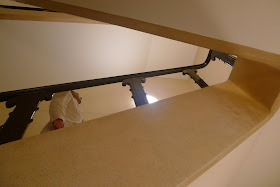
The Guests find Fabrizio Manco
GHost, Hosting II: "Ghost Voices"
17 November 2009, 6.30pm
Court Room, Senate House (South Block)University of London, Malet Street, WC1 7HU
Elena Kamilari, ‘Ghosts on Radio, a Ghost-Medium’, talk and audio
Fabrizio Manco, ‘A GHOST is another PHANTOM?’ performance and talk
Sarah Wishart, ‘Something’s coming through – art and the spectre’s voice’, talk and audiovisual
Julian Wakeling, ‘Ghost Images’, photographic work in progress
Another evening of performance, talks and discussions and another chance to summon the ghost of the blue lady from her hiding place in the Senate Room. November's hosting explored the sounds and noises peculiar to ghosts and their kind.
Elena Kamilari, ‘Ghosts on Radio, a Ghost-Medium’, talk and audio

Elena Kamilari and ghost voices
The paper deals with the way radio, an invisible medium, a “ghost”, implies a presence. I will examine, the way the lack of visual dimension in radio is connected with the intangible essence of ghosts, as they both invite us to use our imagination, in order to create a mental image. I will focus on the strategies that radio play directors use, in order to evoke images of persons, places or actions. In the second part of the paper I will focus on the examples of the radio adaptations of Hamlet and Macbeth and I will examine the way radio signs and codes signify the appearance of the ghosts of Hamlet and Banquo.

Elena and Hamlet + Ghost

Elena, ghost hunting.
Fabrizio Manco, ‘A GHOST is another PHANTOM?’ performance and talk
A GHOST is another PHANTOM? is a live art work in relation to the sound of spaces and a reflection on acoustic phantom perception (and its phantasmagoria) informed by Fabrizio’s experience of chronic tinnitus. The ‘phantom-ghost’ will engage the audience in an initial pedestrian itinerant action through the corridors and rooms of the building. Later they will be asked to write down their phantom and a ghost sound on a piece of paper in envelopes given by the artist at the beginning of the performance. This will be read at the conclusion as part of his talk. The audience is particularly invited to engage and ‘prick up their ears’ and actively listen to the spaces and acoustic changes (and temperatures) of the building. N.B.: This performance requires participants to walk up and down several stairs in search of the hidden noises of Senate House.

Footsteps echo on the stairs - Farizio Manco

Confronted by Ghost noise - Fabrizio Manco

Ghost walk - Fabrizio Manco

Sarah Wishart 'Something’s coming through – art and the spectre’s voiceGraeme Miller’s artwork', 'Linked' talk and presentation
'Linked' re-inserts the stories of the area devastated by the building of the m11 link road, into the space that had forgotten them, through eight-minute audio soundscapes, which audience members pick up via radio receivers. Through the use of images and Miller’s soundscapes, I will take the audience on an incorporeal walk along the route. By exploring my experiences of the walk, I ask if this kind of art has the ability to invoke landscapes from spectral voices, how does it do it on a surface, like a road, that appears to be resistant to the ghosts?

Audience during Sarah Wishart's evocative talk on Graeme Miller's 'Linked'

Sarah Wishart
'Linked' makes contact with the guests






